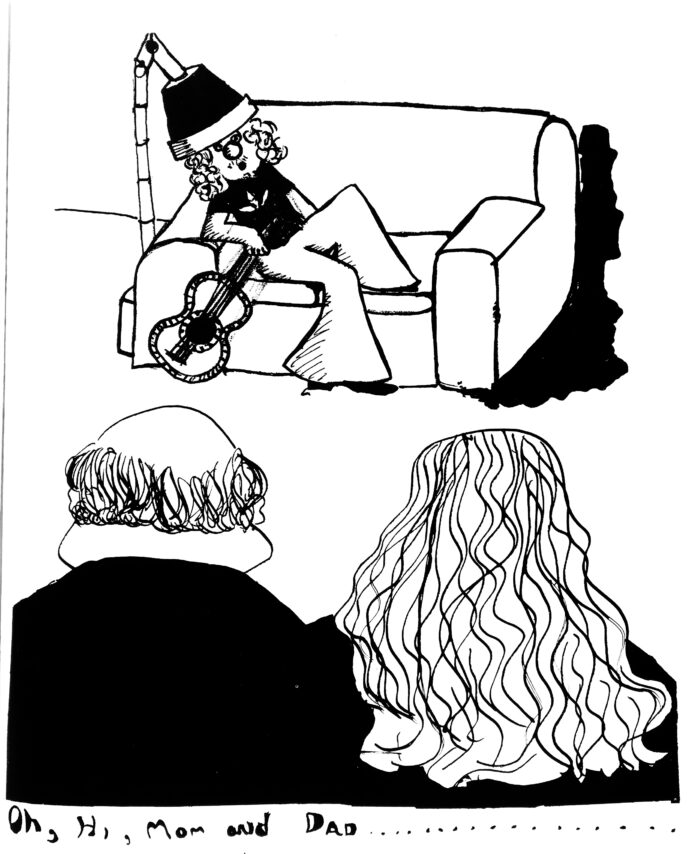by Joan Champ
Long hair for boys was a big thing back in the early 1970s. A quick flip through my high school yearbook of 1972 shows that hardly a single boy had a visible forehead. Besides sweeping bangs, many of my male classmates had hair that flipped up slightly at their shirt collars. Some grew their hair even longer, and some had facial hair – sideburns, moustaches and beards.
It was a fashion statement, a strike against conformity, that all started with the Beatles and their “moptop” hairstyle back in the early 1960s. By the early 1970s, again influenced by the Beatles, the trend was for even longer, shaggier, hair – the “hippie” look – that eventually filtered from youth culture to ordinary working men.
Long hair back then was symbolic of a certain social/political mindset. For a guy, growing his hair long was a sign of non-conformity, of being cool, of solidarity among peers. Long hair also attracted girls. It was a time when a lot of girls, including me, wouldn’t look twice at a boy with short hair.
It was a tough time for barbers. On August 24, 1970, Prince Albert Daily Herald reporter Dennis Gruending wrote a story about the impact on the barbering trade of the “shaggy” look that was much in evidence on city streets. “This trend has certainly made it tougher on the barbers here,” said Cliff Campbell of the Avenue Hotel Barbershop. “People just don’t get their hair cut as often”. Campbell noted that although longer hair started with young people – “the wilder the better” – everyone was beginning to wear their hair longer. Peter Dyck, who ran the Clip Shop, agreed that the barbers’ business has been affected somewhat, but not to a serious degree. “People still need to get their hair cut, they just don’t get it cut as short,’ he told Gruending. Dyck observed that now, ironically, “many businessmen who, a few years ago would never have thought of it, are wearing their hair and clothes to conform to what used to be non-conformism.” Cliff Scott, who worked at the Style Barbershop and Beauty Salon, conceded that the longer styles had definitely hurt business. “We lost the teenagers four years ago,” Scott stated, “but now even businessmen, who were regular two-week customers, are coming in only after four or five weeks.”
As the three barbers reveal, attitudes changed, and soon long hair became an accepted part of everyday life. Some men even started styling their hair, which meant a switch from the barber to the salon. I remember that a couple of boys in my class got perms. Shags, afros, mullets – nothing to bat an eye over. These hair styles represented broader changes within society relating to questions of conformity, permissiveness, changing perceptions of masculinity, and the impact of consumerism and the mass media – big ideas that we are still grappling with today.
Because of negative connotations, long hair could get boys into trouble. Many conservative people and institutions considered long hair to be morally corrupt and just plain wrong. In their minds, long hair was associated with dirtiness, effeminacy, or deviancy. Young men were sometimes forced to cut their hair to get, or keep, a job. Boys with long hair were taunted on the street. “Get a haircut!” I remember friends of mine being provoked into fights at rec centre dances because of the length of their hair.
There are plenty of stories of long-haired students being kicked out of school. In Blaine Lake, for example, a ten-year-old student was expelled in 1971 for breaking the school rule regarding “proper” hair length for boys. The boys’ family challenged the school board’s ruling in Queen’s Bench Court, but, in the days before the Charter of Rights and Freedoms, the judge upheld the school officials’ authority. An editorial in the Herald on September 13, 1971 asked why the length of a boy’s hair was of any concern to school boards. “If current legislation allows school boards to have authority over the lives of students to such a degree that they can arbitrarily dictate how long a student’s hair shall be, then our so-called freedom is certainly in jeopardy,” the Herald wrote. “A Canadian has some rights, even if he is only ten years of age.” Rights and freedoms were not addressed in our Constitution until 1982.
During the same year that schoolboys were being persecuted for their long hair, prisoners at the Saskatchewan Penitentiary in Prince Albert were enjoying a new liberality in hair styles. The Herald reported on September 28, 1971 that a recent directive from Canada’s Solicitor-General’s department allowed male prisoners to have haircuts that conformed “more to the norms existing in the community.” Further, during the 30 days prior to release, “an inmate may have his hair, mustache or beard grow to whatever length he prefers.”
Long hair styles for men have recently made a bit of a comeback. Forget the scraggly ponytail – the man bun and hipster styles have become mainstream. “Plus ça change, plus c’est la même chose.” Although I confess that I don’t remember any man buns in the 1970s!
Contact: joanchamp@shaw.ca


